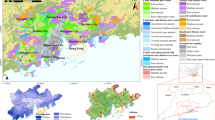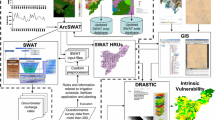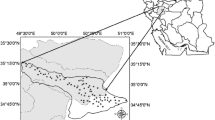Abstract
Shenbei district of Shenyang city, Liaoning province, northeast China is a typical urban–rural (peri-urban) fringe of a megacity that is undergoing rapid urban expansion and the intensification of agricultural management, which threatens the quality of shallow groundwater in the area. This study selects proper indices relevant to vulnerability, stress, function, and adaptability based on the results of groundwater monitoring and the collection and processing of hydrogeological data. Based on the theory of natural disaster risk, an evaluation index system was then established, followed by constructing a groundwater environmental-risk assessment model. Next, the model was used to perform environmental risk grading and spatial pattern assessment on the groundwater based on the statistics and spatial analysis function of ArcGIS. The assessment results were then subjected to a correlation analysis with land use indices and socioeconomic indices, to explore the effects of natural geological conditions, urban expansion and intensive agricultural management on groundwater environment. The results of the study will provide support for land use optimization and water environmental management decision-making during the development and construction of the urban–rural fringe of the area. The results of the study showed that: (1) the spatial distribution of groundwater environmental risk of the Shenbei district is similar to that of groundwater vulnerability. At present, geological conditions are still the main influential factors of groundwater environmental risk in the region; (2) the scale and intensity of urbanization and intensive agricultural management have shown an obvious potential risk to the groundwater environment; (3) the large area paddy fields in the northwest have certain ecological function value, which should be further protected to ensure a win–win situation of agricultural production and environmental safety; (4) it is necessary to put more environmental protection efforts such as ensuring natural vegetation protection, strengthening artificial afforestation, and increasing the number of waste water treatment facilities during the urbanization process, as these measures are significantly effective in maintaining the groundwater quality.





Similar content being viewed by others
References
Aller L (1987) DRASTIC: A standardized system for evaluating groundwater potential using hydrogeological settings. In: Environmental Research Laboratory, US Environmental protection Agency, Ada Oklahoma
Civita MV, Maio MD (2006) Assessment groundwater contamination risk using ArcInfo via GRID function. https://proceedings.esri.com/library/userconf/proc97/proc97/to600/pap591/p591.htm
Davidson RA, Lamber KB (2001) Comparing the hurricane disaster risk of US coastal counties. Nat Hazards Rev 2(3):132–142
Dhanasekarapandian M, Chandran S, Devi DS et al (2016) Spatial and temporal variation of groundwater quality and its suitability for irrigation and drinking purpose using GIS and WQI in an urban fringe. J Afr Earth Sc 124:270–288
Feng P, Li SF, Li JZ (2007) Groundwater environmental risk assessment based on catastrophe theory. J Nat Disasters 17(2):13–18
Feng H, Wei JB, Cheng QG et al (2016) Spatial analysis of heavy metals contamination of shallow groundwater in relation to urban sprawl and intensive agricultural development. Territory Natural Resour Study 3:83–88
Foster SSD (1986) Getting to grips with groundwater pollution protection in developing countries. Nat Resour Forum 1:51–60
Foster SSD (2001) the interdependence of groundwater and urbanization in rapidly developing cities. Urban Water 3:185–192
Huan H, Wang JS, Teng YG (2012) Assessment and validation of groundwater vulnerability to nitrate based on a modified DRASTIC model: a case study in Jilin City of northeast China. Sci Total Environ 440:14–23
Huan H, Wang JS, Zhai YZ et al (2016) Quantitative evaluation of specific vulnerability to nitrate for groundwater resource protection based on process-based simulation model. Sci Total Environ 550:768–784
Hui R, Wescoat JL (2019) Visualizing peri-urban and rurban water conditions in Pune District, Maharashtra, India. Geoforum 102:255–266
Jia SQ (2017) Groundwater vulnerability and health risk assessment in Shenbei New District. In: Master's thesis of Shenyang University
Jiang WG, Li J, Chen YH et al (2008) Regional flood disaster risk assessment system—principles and methods. J Nat Disasters 17(6):53–59
Lee KJ, Yun ST, Kim KH et al (2019) The combined use of self-organizing map technique and fuzzy c-means clustering to evaluate urban groundwater quality in Seoul metropolitan city, South Korea. J Hydrol 569:685–697
Lezzaik K, Milewski A (2018) The groundwater risk index: development and application in the Middle East and North Africa region. Sci Total Environ 02:1149–1164
Li SF, Feng P, Lin C (2007) Discussion and application of groundwater environmental risk assessment index system. Arid Area Resour Env 21(1):38–43
Li RZ, Wang MW, Jin JL (2010) Fuzzy multiple index analysis method for groundwater environmental risk. Geogr Sci 30(2):229–234
Masoud AA (2014) Groundwater quality assessment of the shallow aquifers west of the Nile Delta (Egypt) using multivariate statistical and geostatistical techniques. J Afr Earth Sc 95:123–137
Minolfi G, Albanese S, Lima A et al (2018) A regional approach to the environmental risk assessment—Human health risk assessment case study in the Campania region. J Geochem Explor 184(2):400–416
Morris BL, Lawrence AR, Stuart ME (1995) The impact of urbanization on groundwater quality. In: British geological survey technical report
NRC (1993) Ground water vulnerability assessment: contamination potential under conditions of uncertainty. National Academy Press, Washington, DC
Pacheco FAL, Martins LMO, Quininha M et al (2018) Modification to the DRASTIC framework to assess groundwater contaminant risk in rural mountainous catchments. J Hydrol 09:175–191
Rebolledo B, Gil A, Flotats X et al (2016) Assessment of groundwater vulnerability to nitrates from agricultural sources using a GIS-compatible logic multicriteria model. J Environ Manag 171:70–80
Sun CZ, Zhu J (2014) Environmental risk assessment and spatial correlation of shallow groundwater in the lower liaohe Plain. Geogr Progress Sci 33(2):270–279
Teng YG, Zuo R, Xiong YN et al (2019) Risk assessment framework for nitrate contamination in groundwater for regional management. Sci Total Env 2019:697. https://doi.org/10.1016/j.scitotenv.2019.134102
Vrba J, Japorozec A (1994) The guide book on mapping groundwater vulnerability. In: International Association Hydrogeologists, Hannover: Verlag HeinzHeise
Zeng B, Zhang ZX, Yang MY (2018) Risk assessment of groundwater with multi-source pollution by a long-term monitoring programme for a large mining area. Int Biodeterior Biodegrad 128:100–108
Zhang LZ, Kong HY, Chen K (2018) Groundwater environmental risk assessment technical method. Env Dev 02:14–16
Acknowledgements
This work was supported by the National Natural Science Foundation of China (Grant nos. 41771200 and 41171399).
Author information
Authors and Affiliations
Corresponding author
Additional information
Publisher's Note
Springer Nature remains neutral with regard to jurisdictional claims in published maps and institutional affiliations.
Rights and permissions
About this article
Cite this article
Jianbing, W., Na, Z., Quanguo, C. et al. Simulation and evaluation of the spatial heterogeneity of shallow-groundwater environmental risk in an urban–rural fringe of megacity: a case study of Shenyang city, northeast China. Environ Earth Sci 79, 250 (2020). https://doi.org/10.1007/s12665-020-08975-8
Received:
Accepted:
Published:
DOI: https://doi.org/10.1007/s12665-020-08975-8




